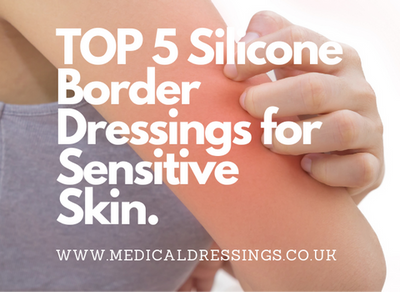Posted by Warren M on 7th Oct 2022
How To Dress a Wound?
How to dress a wound properly is one of the most basic and important first aid skills there is. The process remains is generally the same no matter of the size or severity of the injury. Whether it's a child's skinned knee, a gunshot wound, wound ulcer, post operation wound, the tenets of dressing a wound are the same.
Minor cuts and scratches can be treated at home or on the road. Larger lacerations may also need to be dressed until medical help can be obtained. Cleanliness is key. A saline solution is ideal for cleaning out any debris and reducing chances of infection.
The following products are ideal for the task:
- STERICLENS STERILE IRRIGATION WOUND SPRAY
- IRRIPOD SALINE IRRIGATION SOLUTION 0.9W/V SODIUM CHLORIDE 20ML
- WOUND CLEANSING SALINE WIPES (BOX OF 100)
Infection Control
Encountering someone else's blood poses risks, such as transmitting certain diseases. It is important to protect yourself from any transmittable diseases. Protect yourself by following universal precautions and wearing personal protective equipment such as a mask, gloves, an apron. Make sure the surrounding areas are covered if the wound is emitting fluid. Dispose of any used dressings or cleaning material in a sealable bag.
The following products are ideal for the task:
Bleeding Assessment
A small amount of bleeding is okay as it helps flush dirt and other contaminants out of the wound, but heavy bleeding is bad.
Call 999 if there's:
- Bright red or squirting blood
- A puncture wound on the head, neck, chest, abdomen, pelvis, or back is more than an inch deep
- A deep puncture wound on an arm above the elbow or a leg above the knee
- Do what you can to stop the bleeding. Use a belt or anything around you to help.
Heavy bleeding can be controlled using a hemostatic (blood clotting) dressing. The sodium and calcium salts in the dressing help blood clot as the site of the wound.
The following products are ideal for the task:
Clean the Wound
- Wash your hands.
- Clean the wound with a saline solution.
- Wash the skin around the injury with saline solution and a sterile gauze swab. It may sting and irritate any raw tissue.
- Rinse the wound thoroughly with the saline solution to rid it of any dirt and exudate.
- Allow the area to dry.
- Use tweezers to remove particles (like broken glass or gravel).
- Antibacterial ointments can be applied to reduce chances of infection and promote wound healing by providing an optimum environment.
The following saline solutions are ideal for the task:
- STERICLENS STERILE IRRIGATION WOUND SPRAY
- IRRIPOD SALINE IRRIGATION SOLUTION 0.9W/V SODIUM CHLORIDE 20ML
- WOUND CLEANSING SALINE WIPES (BOX OF 100)
The following gauze swabs are ideal for the task:
- TOPPER 8 STERILE GAUZE SWABS 7.5CM X 7.5CM 4PLY
- PREMIUM NON-STERILE GAUZE SWABS
- PREMIUM NON-WOVEN 4PLY STERILE GAUZE SWABS (BOX OF 100)
- STERILE GAUZE DRESSING - ASSORTED (PACK OF 120)
The following ointments are ideal for the task:
- ACTIVON MANUKA HONEY 25G TUBE FOR WOUNDS & BURNS
- IODOSORB IODINE OINTMENT
- FLAMINAL FORTE GEL 15G & 50G
Dressing the Wound
Only cover the wound if it's likely to come in contact with clothing or dirt or if its persistently producing fluid.
Adhesive bandages and dressings are the easiest way to cover most wounds from post operation wounds, ulcers to guts and grazers. Make sure to use a sterile dressing to avoid infection.
Basic adhesive Non-Waterproof dressings ideal for minor postoperative wound treatment, general grazes and the first aid kits:
- MEPORE SELF ADHESIVE DRESSING
- COSMOPOR E HYPOALLERGENIC STERILE DRESSING
- PRIMAPORE ADHESIVE WOUND DRESSING
- 3M MEDIPORE PLUS PAD STERILE ADHESIVE DRESSING
- MELOLIN ADHESIVE DRESSING
- ADHESIVE STERILE HYPOALLERGENIC WOUND DRESSING (BOX OF 25)
- ADHESIVE WOUND DRESSINGS- ASSORTED - (BOX OF 30)
Basic adhesive Waterproof dressings ideal for minor postoperative wound treatment, general grazes and the first aid kits:
- SOFTPORE ADHESIVE WATER REPELLENT DRESSING
- CLEARPORE TRANSPARENT DRESSING POST OP FIRST AID
- MEPORE ULTRA WATERPROOF DRESSING
- OPSITE POST-OP BREATHABLE ADHESIVE DRESSING (WATERPROOF)
- TEGADERM + PAD FILM DRESSING (3M)
- MEPORE FILM & PAD
Shallow cuts less than 2 centimetres long can be held closed with butterfly adhesive wound closure strips. If the edges of a laceration are not easily pulled together, then the wound may need stitches.
The following wound closure strips are ideal for the task:
- STERILE ADHESIVE WOUND CLOSURE STRIPS 6CMX75CM (BOX OF 150) 3 STRIPS PER SACHET
- STERILE SUTURE STRIPS ASSORTED (PACK OF 150)
- BUTTERFLY CLOSURE STRIPS (PACK OF 100)
- 3M STERI-STRIP REINFORCED SKIN WOUND CLOSURES
When to Call Your Doctor
Deep lacerations extend into the tissues below the skin. If you can see layers of tissue along the sides of the laceration, it's pretty deep. Puncture wounds are harder to evaluate and should be based on how long the offending object is.
Seek medical attention for a deep wound if it's:
- Tender or numb
- Inflamed (red and swollen)
- Draining pus (yellowish, thick liquid)
- A laceration with jagged edges or won't close
- Also, get medical help if it's been more than five years since the victim had a tetanus shot.



